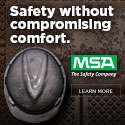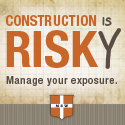
| www.agc.org • June 2017 |
Contact Us Archives
Subscribe Printer-Friendly AdvertiseSafety and HealthFacebook |
Why It's Important to Have a Plan B BY CHRIS HOLBERT
SECURATRAC
The construction industry was the number one workplace for fatalities in 2015 according to the Occupational Safety and Health Administration (OSHA). There were a total of 4,379 worker fatalities in private industry in 2015 and 21.4 percent of those deaths were workers in the construction industry. These numbers make it evident that construction executives need solutions for monitoring the health and safety of their workers. And, workers need the most efficient means possible to report and react to emergencies.
Excluding highway collisions, the top causes of death in the construction industry were falls, a person being struck by an object, electrocution, and a person being caught-in or between objects. The Bureau of Labor Statistics sites that in 2015 these four causes were responsible for 64.2 percent of construction worker deaths.
These causes of death illustrate how difficult it could be for a construction worker to place a 911 call in an emergency. After a fall or being struck by an object, a worker could likely be unconscious. A common scenario for each of these causes is the inability of the construction worker to make use of a cell phone to reach help.
According to the Pew Research Center, approximately 95 percent of Americans now own a cell phone of some type and more than one-third own a smartphone. While these devices provide many conveniences, in emergency situations these devices remain highly limited.
For example, a cell phone is not able to detect if someone slipped off a roof, triggered a staple gun and sent a nail through a hand or foot, or any number of other emergencies that can occur on a jobsite. With a cell phone the user is still required to be conscious and within range of the phone to be able to make a call for help. In the case of mobile workers and lone workers, these devices are not the most reliable or function-rich options for tracking and monitoring employee safety and health. Additionally, in the case where a lone worker is confronted by a hostile third party, the cell phone is the first item often taken so as to prevent a call for help.
A better solution is relying on easily worn devices (i.e., wearables or wearable devices) that automatically report changes that could indicate an emergency. Another option is a device that a worker could easily utilize to express the need for help without having to speak or make much of a movement.
Fueled greatly by consumers rapidly adopting fitness trackers and smart watches, the global wearables market is expected to reach a value of $19 billion in 2018. But, the construction industry could also become an influential customer shaping this evolving space. Already there are products like smart hard harts, smart safety vests, smart eyewear and even stick-on patches that can monitor everything from an employee’s location to body temperature and positioning. These devices eliminate the need for a worker to proactively report an emergency, but like cell phones they have their limitations.
For example, while the devices are able to transmit certain information about a situation to a manager or human resources department, they do not create a direct line of communication between the worker and responder. If verbal communication is possible in the emergency situation, the worker would still need to place a call on a phone.
Potentially a better option for the construction industry would be mPERS devices, similar to those used by seniors for years. Essentially, they are help buttons that can be pressed after a fall to alert emergency responders that assistance is needed. These types of technologies have become more beneficial because they no longer require a base station device to place calls, limiting their range of use.
Like other wearables, mPERS devices are small and lightweight. They provide state-of-the-art location technologies, and also offer built-in fall advisory capabilities. Wearables with this type of functionality are able to detect horizontal and vertical movement, but taking it a step further than simply reporting a fall on the job via a text message or red flag in a software system, mPERS devices can also eliminate the need for the worker to initiate a call for help. Instead, they can trigger one automatically. And, cloud-based technologies can make it possible for central stations to immediately respond to the call for help.
Another benefit of mPERS devices is the long battery life. Unlike phones that sometimes have to be charged multiple times a day, mPERS devices have less functions and do not need to be fully functional at all times. They can be left off or essentially in a hibernation mode until the SOS button on the device is pressed. Once this action occurs, location information can be sent to a central reporting destination and an emergency call can be placed. This enables mPERS devices to have battery lives of up to 30 days on one charge.
Whatever wearable device makes the most sense for a particular construction company, the most important factor is that business owners and managers take advantage of these new technologies that could potentially save lives and improve the safety and health of their employees. Chris Holbert is CEO of SecuraTrac, an expert in mobile safety solutions. |
|||
 2300 Wilson Boulevard, Suite 300 · Arlington, VA 22201 · 703-548-3118 (phone) · 703-548-3119 (fax) · www.agc.org
2300 Wilson Boulevard, Suite 300 · Arlington, VA 22201 · 703-548-3118 (phone) · 703-548-3119 (fax) · www.agc.org
About AGC | Advocacy | Industry Topics | Programs and Events | Career Development | News & Media
© Copyright 2024 The Associated General Contractors of America. All rights reserved.

